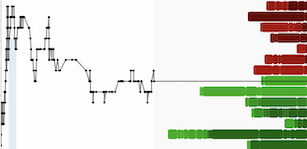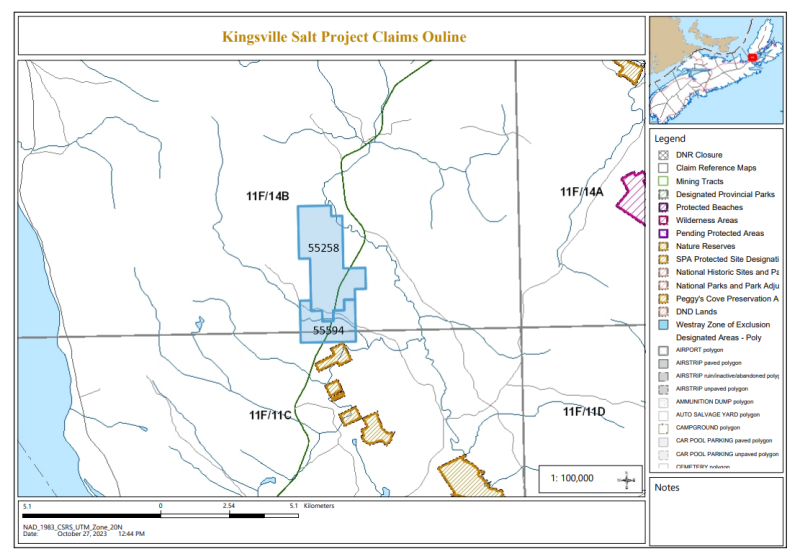(TheNewswire)
Montréal, QC – TheNewswire - September 25, 2024 – QNB Metals Inc. (CSE: TIM.X) (USOTC: QNBMF) is pleased to announce the successful completion of its National Instrument 43-101 Technical Report for the Kingsville Salt Project located in Nova Scotia, Canada.
This milestone represents the fulfillment of a key condition outlined in the proposed Joint Venture agreement with RéSolve Energy, as previously disclosed on September 19, 2024.
The NI 43-101 report underscores the Company’s commitment to transparency, technical excellence, and compliance with industry standards and Canadian Security Exchange (the “CSE”) requirements. QNB Metals remains dedicated to advancing the Kingsville Salt Project in collaboration with our partner, RéSolve Energy.
Kingsville Salt Property Overview
The Kingsville Salt Project is located approximately two (2) kilometers south of the municipality of Kingsville, about five (5) kilometers north of the municipality of Queensville, and seventeen (17) kilometers northeast of the Municipality of Port Hastings, in Inverness County on Cape Breton Island.
As of November 16, 2023, the Kingsville Salt Project, encompassing two adjacent Exploration Licenses (EL), covering a total area of 907 hectares (9.06 km2). The Project, situated within the NTSC grid sheets 11F14 and 11F11, is primarily on private property with a portion on Crown land. The Company has full ownership of the property interests, representing 100% ownership.
The southern segment of the project is readily accessible through Route 105, supplemented by intersecting paved roads that traverse the property and are sustained throughout the year. The remaining portion of the project, while less accessible, can be, in part, reached via private forestry roads, subject to the acquisition of necessary permissions.
Kingsville Salt Project’s Claims Outline
In Nova Scotia, all the known salt deposits are found in the lower Carboniferous period, which is part of the Maritime Basin. The Carboniferous Basin, the largest basin in the Appalachian region, covers about 150,000 square kilometers, most of which is offshore. The area is made up of layers of rocks that formed on land, but over time, it has been changed by local faults and the movement of salt underground. The rock layers from this period can be broken down into three main cycles: the Horton Cycle, the Windsor-Mabou Cycle, and the Cumberland-Pictou Cycle. These cycles involve things like the filling of the basin, the sinking of land, and the buildup of different kinds of rocks. The Strathlorne-Ainslie Formation in the lower Carboniferous Horton Group covers older highland rocks. The lowland areas of the Carboniferous Basin are generally lower than 50 meters above sea level and are located in valleys, while the higher lands are made of older rock formations. The lowlands are also covered by a thick layer of glacial material.
The basin is thought to be a special kind of land depression (zeugogiosyncline), sitting next to a raised area, and it includes many smaller sub-basins within the Maritimes basin. Faults can be seen in this region. The angle of the dips in the rocks gets steeper as you move away from the center of the basin toward the anticline over the Kingsville structure, showing the effects of underground salt movement on the Carboniferous rock layers above. The rocks in this basin are typical of those found in continental basins and include layers of immature sandstone, shale, and conglomerate. In the early 1960s, a gravity survey hinted at the presence of Windsor evaporites and salt. The area had been explored for salt and potash, but no signs of salt were found at the surface, which is common when salt is buried deep underground.
The Kingsville deposit is mainly made up of halite (salt) and has been studied through 11 drill holes. It lines up with a large gravity low area that stretches over 4000 meters. This structure is thought to be a diapiric antiform, which means it has a long, curved fold with steep sides and a downward slope to the south.
In reports from Domtar Inc. in 1972* and 1978, they estimated the salt reserve to include 31.63 million tons of Proven reserves and 1.152 billion tons of Probable reserves**, with a salt purity of more than 90% NaCl. These numbers come from a drilled area about 2400 meters long and 900 meters wide, reaching a depth of 1220 meters.
The first layer of salt starts between 400 and 500 meters deep, with the deeper end located in the southern part of the deposit. Domtar Inc. (1978) divided the salt into four grades:
-
Very high grade: over 95% NaCl
-
High grade: 90-95% NaCl
-
Medium grade: 75-90% NaCl
-
Low grade: 60-75% NaCl
Several drill holes (DK-5, DK-6, DK-7, and DK-9) showed large amounts of very high and high-grade salt. No significant amounts of potash salts were found in any of the drill hole logs or analyses.
|
Hole Number |
Intervals (Feet) |
Apparent Thickness |
NaCl Grade |
|
DK-6 |
2325.1-2497.5 |
172.4’ |
96.4% |
|
DK-6 |
2721.7-2847.6 |
125.9’ |
95.17% |
|
DK-6 |
2976-3169.1 |
193.1’ |
95.82% |
|
DK-6 |
3278-3600.3 |
322.3’ |
96.22% |
|
DK-7 |
1968-2293 |
325’ |
97.64% |
|
DK-7 |
2342-2569.7 |
227.7’ |
97.54% |
|
DK-7 |
3008-3198 |
190’ |
97.13% |
|
DK-7 |
3410-3552 |
142’ |
96.82% |
|
DK-7 |
3588-3648 |
60’ |
96% |
In 2002, Intragaz reclassified the salt grades to better show the impurities in the halite (salt) deposits. (Duchaine, Dupéré, and al, 2002) The new classifications are:
-
Salt: Where the NaCl (salt) content is 80% or more by weight.
-
Anhydritic Salt: Where the NaCl content is 80% or more, and there is at least 5% Anhydrite by weight.
-
Salt Silt: Where the grain size is the same as silt, and the NaCl content is between 50% and 80%.
-
Dirty Halite: Where the grain size is smaller than silt (like mud or clay), and the NaCl content is also between 50% and 80%.
-
Other Rock Types: Where the NaCl content is less than 50% of the total weight.
* Reported by Domtar inc. in 1972; Rowbottom, E.T. (Domtar Limited)1972. Geology report, Maritimes Salt Project, Nova Scotia; Nova Scotia Department of Mines and Energy, Assessment Report 11F/10C 42-O-21(01). - The reserves were estimated before the establishment of the 43-101 norm and thus the reserves categories does not reflect the categories of the reserve’s classification under the norm and the drilling, sampling and assaying would have to be redone following the adequate QAQC process to be reported today.
** Domtar Chemicals Group, 1978: Proposal to the United State Department of Energy for a Strategic Petroleum Reserve in Cape Breton, Nova Scotia. Vol. III - Domtar Chemicals Group, 1978.
Qualified Person
The technical content of this news release has been reviewed and approved by Patrick Laforest, B.Sc., MBA, P.Geo. who is an independent Qualified Person (QP) as defined in National Instrument 43-101, Standards of Disclosure for Mineral Projects. The QP and the Company have not completed sufficient work to verify the historic information on the properties, particularly regarding historical exploration, neighbouring companies, and government geological work.
About the Corporation
QNB Metals is an exploration-and-development-stage company focused on leveraging its salt assets for mining, energy storage, as well as carbon capture and sequestration.
For further information, please contact:
Stéphane Leblanc, Chief Executive
Officer
Email: sleblanc1313@hotmail.com
Neither the CSE nor its Regulation Services Provider accepts responsibility for the adequacy or accuracy of this release.
This news release includes certain “forward-looking statements” under applicable Canadian securities legislation. Forward-looking statements are necessarily based upon several estimates and assumptions that, while considered reasonable, are subject to known and unknown risks, uncertainties, and other factors which may cause the actual results and future events to differ materially from those expressed or implied by such forward looking statements. Such factors include, but are not limited to general business, economic, competitive, political, and social uncertainties, and uncertain capital markets. Readers are cautioned that actual results and future events could differ materially from those anticipated in such statements. Accordingly, readers should not place undue reliance on forward-looking statements. The Company disclaims any intention or obligation to update or revise any forward-looking statements, whether as a result of new information, future events or otherwise, except as required by law.
Copyright (c) 2024 TheNewswire - All rights reserved.






